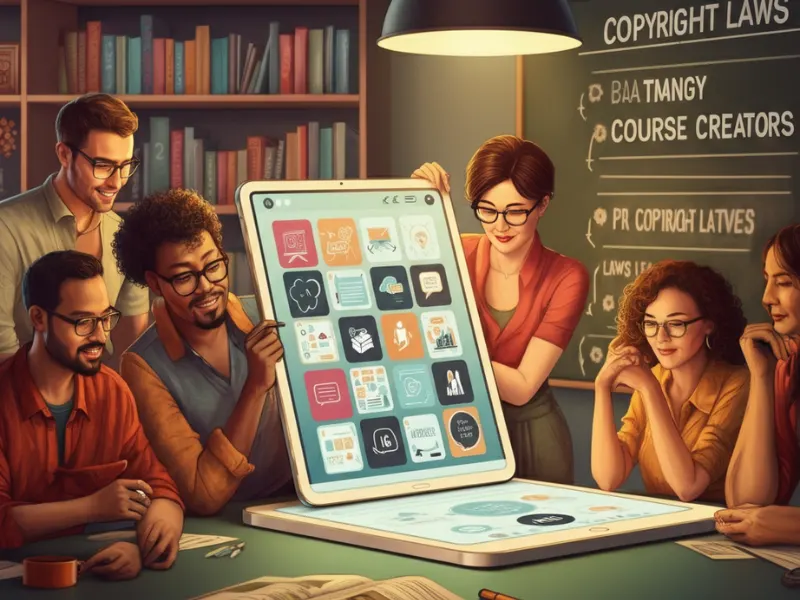As online learning continues to grow, ensuring the originality of course content has become more crucial than ever. For educators and course creators, originality is more than just a legal or ethical requirement. It plays a vital role in maintaining your credibility, engaging your students, and setting your course apart in a competitive market.
When learners invest in online education, they expect value. Recycled or plagiarized material diminishes that value, leaving students dissatisfied and potentially damaging your reputation. If you’re an online instructor or course creator, this guide will empower you with the knowledge and tools to create original courses that resonate with your audience.
By the end of this post, you’ll understand the importance of intellectual property, learn practical ways to ensure your content is unique, and discover tools to check for plagiarism. You’ll also find guidance on fostering originality among students and the legal repercussions of failing to uphold this educational standard.
Understanding Copyright and Intellectual Property
Before creating an original online course, it’s essential to understand copyright and intellectual property laws. These laws protect the rights of original creators, ensuring they are credited for their work and compensated appropriately.
Copyright refers to the legal protection granted to original works, whether written, visual, or audio. This means you can’t reproduce, distribute, or adapt someone else’s material without permission unless it falls under specific exceptions like “fair use.”
Examples of copyrighted material you might encounter include books, images, videos, and even PowerPoint templates.
Intellectual Property (IP) covers creations of the mind, such as course curricula, unique teaching methods, and branded materials. For example, if you’ve created a unique framework or methodology for your course, that innovation is your intellectual property.
Failing to respect copyright and IP can result in legal consequences, but just as importantly, it could harm your reputation as an educator. Knowing and respecting these rules is the first step in creating an impactful course.
Practical Steps to Ensure Your Course Content is Original
Crafting unique and valuable content requires a strategic approach. Here are practical steps to ensure the originality of your course materials:
1. Start with Your Own Expertise
Anchor your content in personal knowledge and experience. Reflect on the core skills, insights, or expertise that only you can bring to the table. Your unique perspective is your most significant competitive advantage.
2. Conduct Thorough Research
While inspiration from other courses and materials is fine, ensure you go beyond surface-level replication. Instead, synthesize the information you gather, analyze diverse viewpoints, and present your insights in your voice.
3. Reference Credibly
If you’re using external material, make sure to give credit where it’s due. This includes citing authors, linking to original sources, and clearly distinguishing your content from referenced material. Not only does this add credibility, but it also models ethical behavior for your students.
4. Create Original Graphics and Examples
Rather than using stock visuals or reworking common examples, develop custom visuals and relevant, relatable examples based on your audience’s interests or challenges. Tools like Canva or Figma can help you design unique graphics that reflect your brand.
5. Edit and Revise Thoroughly
Once you complete your first draft, review it with a critical eye. Are there sections that feel generic or overly similar to existing material? Editing allows you to streamline your content and make it uniquely yours.
Tools and Resources for Checking Plagiarism
Even when you create with the best intentions, unintentional duplication can occur. Plagiarism-checking tools can help you ensure your content is free from accidental overlaps. Here are three powerful tools to consider:
- Turnitin: Widely used in academia, this tool checks written content against a vast database of academic papers, journals, and online text.
- Copyscape: Ideal for online course creators, Copyscape compares your material against published web content to identify instances of duplication.
- Grammarly Premium: Beyond grammar and style suggestions, Grammarly includes a plagiarism checker to ensure your work is clean.
Using these tools regularly ensures you maintain professional standards and deliver truly original content to your learners.
How to Foster a Culture of Originality Among Students
Teaching originality should extend beyond your materials to the classroom environment itself. Encouraging students to value creativity and innovation can have a profound impact on their academic and professional lives. Here’s how to foster originality among your learners:
1. Promote Critical Thinking
Ask students to analyze course material and encourage them to form their own opinions. Offer open-ended assignments that push them to explore rather than repeat.
2. Value the Process Over the Outcome
Encourage students to document their thought process when completing assignments. Praise ingenuity and unique approaches to problem-solving.
3. Use Plagiarism Detection Tools
Educate students about plagiarism and allow them to use tools like Turnitin to verify the originality of their work before submission.
4. Encourage Peer Feedback
Ask students to review each other’s work. This not only helps them learn from peers but also sets a standard of accountability and originality.
Legal Consequences of Plagiarism and Copyright Infringement
Plagiarism and copyright infringement carry significant legal consequences. For course creators, this could mean lawsuits, hefty fines, or the removal of your materials from platforms.
Some platforms, like Udemy and Teachable, have strict copyright enforcement policies to protect creators and learners alike. Ignoring these rules can result in your courses being taken down.
Always ensure you own the rights to the content you publish or have obtained proper permissions. Protecting your intellectual property is vital, both for your peace of mind and the credibility of your online courses.
Originality as a Core Value in Education
Originality is more than just a checkbox in online education; it’s a fundamental value that defines the quality and effectiveness of your course. By valuing originality, you’re not just protecting your intellectual property but also offering your students an enriched learning experience.
Remember, originality doesn’t mean doing it all alone. Inspiration is everywhere. Borrow ideas, analyze trends, and learn from the best—but always present your content through your unique lens.
If you’re ready to take your course creation to the next level, we’re here to help. Explore new tools, connect with like-minded professionals, and refine your content into something truly unforgettable. The first step? Start building your course, your way, today.






